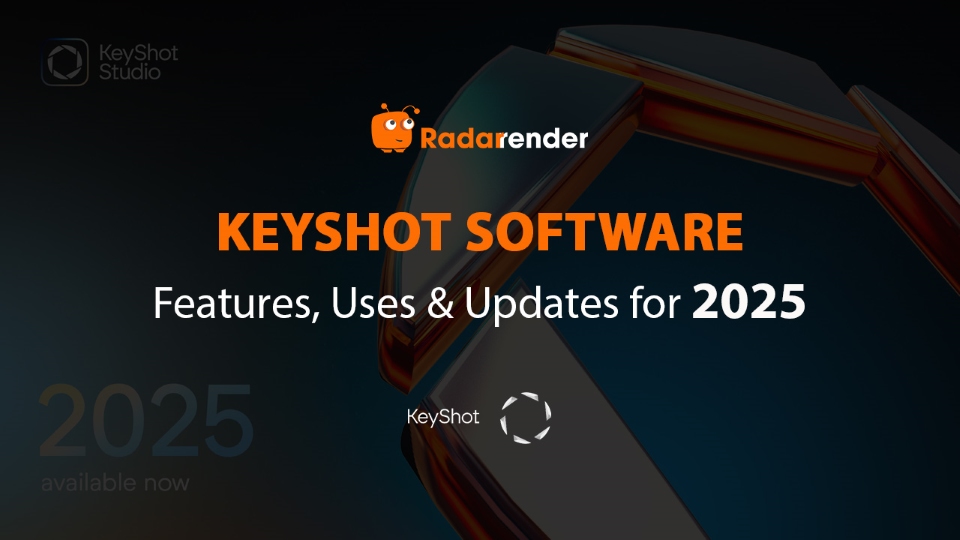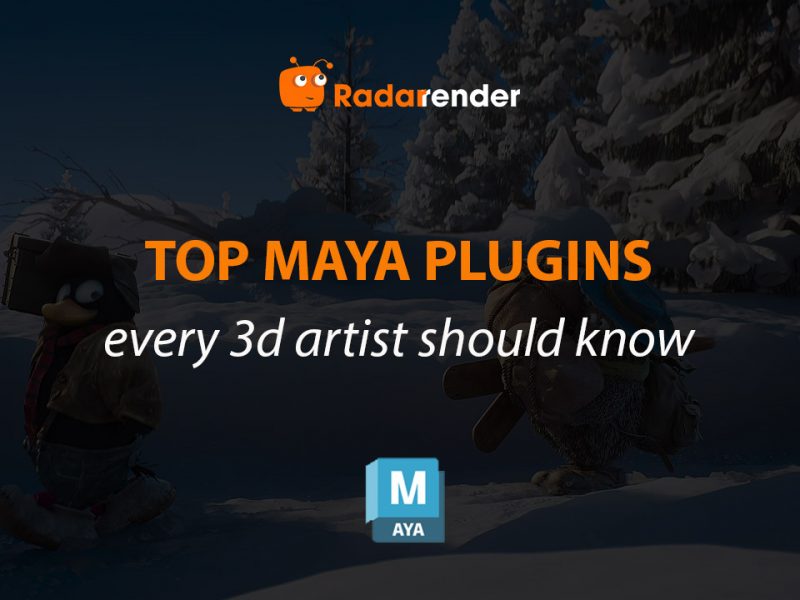KeyShot Software: Features, Uses & Updates for 2025
Keyshot software has been a popular choice in the graphics world for a long time, and it is also my favorite choice. Recently, KeyShot 2025 has just dropped, so I took the opportunity to dive into what’s new, what’s changed, and whether this update is worth it.
In this post, I’ll share everything I’ve learned, from what makes KeyShot unique to the features I rely on most, and what’s improved in the 2025 version. Whether you’re a product designer, 3D artist, or marketing creative, this breakdown of KeyShot software will help you decide if it’s the right fit for your 2025 projects. Let’s go with Radarrender!
What is KeyShot?
KeyShot is a standalone, real-time global illumination and ray tracing program used to create 3D renderings, animations, and interactive visualizations. What sets KeyShot apart is that you can create photorealistic images with very little setup. This software emphasizes drag-and-drop functionality, real-time previews, and an extremely streamlined interface.

The History of KeyShot
KeyShot was developed by Luxion, a company founded by Henrik Wann Jensen – a renowned computer graphics researcher, and Claus Wann Jensen – a software engineer. Actually, Bunkspeed first released KeyShot in 2007 as Hypershot, with the software licensed from Luxion, Inc. But Bunkspeed stopped paying for that license, and in 2010, Luxion relaunched the software as KeyShot. The first version of KeyShot made a splash by providing a real-time ray tracing tool that any artist could use.
Over the years, Luxion has continued to release updates, improving performance and adding features. Today, KeyShot is not only a powerful rendering engine but also a leading business technology platform for product design.
Who Uses KeyShot?
With nearly 3,000 companies of all sizes and thousands of 3D artists worldwide using KeyShot, it’s clear that the software is popular across various industries.
- Product design: KeyShot claims to be the leading Product Design-to-Market Suite, empowering companies worldwide to turn product visions into market-ready realities.
- Industrial design: Compatibility with CAD software and accurate material libraries.
- Marketing and advertising: Ability to quickly render sharp, realistic images.
- Architecture and interior design: While not as popular in product design, some people use KeyShot for quick visualizations.
- Jewelry and watch design: Ability to simulate metals and gemstones accurately and sparklingly.
Personally, what I find most valuable about KeyShot is how accessible it is, and the ability to simulate and render beautiful diamond jewelry sets that sparkle brilliantly is insane.
Key Features of KeyShot
Here are some main features of KeyShot that make KeyShot so widely loved:
- Real-Time Rendering: You see your scene updates instantly with no waiting for test renders or setting up complicated render regions. This makes iteration incredibly fast.
- Material Library: KeyShot has a comprehensive library of pre-made materials that can be easily applied to models. Users can also create custom materials to achieve specific looks.
- Lighting Control: It supports HDRI environments, physical lighting (spot, point, area lights), and global illumination, which helps model lighting scenarios with ease.
- Animation Tools: KeyShot includes basic animation capabilities like part rotation, camera movement, and exploded views. These are especially helpful in product demos.
- AI Denoising: It uses machine learning-based denoising to drastically reduce render times, especially for complex scenes.
- Plugins and Integration: KeyShot supports various plugins and works well with popular 3D modeling software like Autodesk Fusion 360, Rhino, SolidWorks, and many others, allowing for seamless integration into existing workflows.
- Import and Export Options: It supports more than 20 major 3D file formats, including SketchUp, SolidWorks, Solid Edge, Pro/ENGINEER, PTC Creo, Rhinoceros, Maya, 3ds Max, IGES, STEP, OBJ, 3ds, Collada, and FBX and USD, allowing you to go from import to final rendering in minutes.
KeyShot Rendering
For a long time, Keyshot was solely a CPU-based rendering engine, but in recent versions, GPU support has also been added with single and multi-GPU rendering options. Obviously, GPU-based rendering is usually faster, but the complexity of what it can do is limited by the amount of video memory the GPU has. Whereas CPU rendering uses system memory (RAM), which can be much larger, so it is slower but efficient for rendering large projects.
KeyShot comes with two main rendering engines:
- CPU Renderer (default) – Highly optimized for multi-core CPUs. This is great for users with powerful workstations.
- GPU Renderer (requires NVIDIA RTX) – Faster and more efficient, especially for scenes with high lighting complexity. As an RTX 4090 user, I have seen rendering up to 3x faster than using the CPU alone.
You can switch between the two engines in real-time, depending on your system specs and rendering needs.

KeyShot Pricing
KeyShot software offers a variety of license plans with different benefits. You can also contact their sales team to customize a service plan with features specific to your team. Here are the public license plans:
- KeyShot Studio Professional: $99.00 per month – Billed yearly, total annual cost $1,188.00
- KeyShot Hub: Request pricing – Designed as a centralized platform
- KeyShot Dock: Request pricing – Streamline and manage assets with comprehensive DAM functionality.
Upgrade your workflow with KeyShot Add-ons:
- KeyShot Studio Web: $39.00 per month – Billed yearly, total annual cost $468.00
- Network Rendering: $32.00 per month – Billed yearly, total annual cost $384.00 for 32 Cores. Other configurations with separate prices.
- NX Plugin: $29.00 per month – Billed yearly, total annual cost $348.00
- KeyShot Studio VR: $99.00 per month – Billed yearly, total annual cost $1,188.00
KeyShot also offers a 14-day trial so you can try it before you buy. Note that the trial includes all features except Save, Background Render, and Rendering Queue. And Render output is watermarked. To be honest, KeyShot’s price is quite expensive compared to other software, especially for individual users or small businesses.
KeyShot System Requirements
As mentioned above, KeyShot currently supports both CPU and GPU rendering, so choosing a powerful CPU or GPU computer setup will depend on your KeyShot render mode.
Minimum System Requirements
- 64-bit platform
- 4GB RAM
- Quad-core CPU
- OpenGL 2.0 capable system
- CPU: Intel or AMD 64-bit processor with SSE4.1 or higher (Intel Xeon except for Xeon Phi and/or AMD Ryzen).
- GPU: QUADRO RTX 4000 or higher with at least 8GB RAM.
- 1920 x 1080 resolution or higher
- Internet connection (to activate product)
Microsoft Windows:
- Windows 10 or 11
- Windows Server 2019 and above.
MacOS
- macOS 11.7 Big Sur or newer
Note: KeyShot will utilize all available CPU cores. Therefore, more CPU cores/threads will produce faster rendering times.
Review KeyShot 2025
New Updates
We have been waiting for Keyshot 2025, now that Keyshot 2025.1 has just dropped with a handful of features, here are my top 5 favourite updates. Let’s check them out!

1. Brand new type of light – Planar Lights
Planar Lights are specifically designed to represent the softboxes (large light diffusers) that real-life photographers use. It includes barndoors that are similar to physical softboxes. The size and shutter angle of the barndoors are easily adjustable, meaning you can recreate common lighting setups from real-life photography faster and easier. This also helps with faster rendering and supports more features down the road.
2. New light positioning tools
The all-new light positioning tool allows users to easily place and direct physical lights without having to rely on a 3D move tool. Simply drag your mouse across the 2D rendered image in real-time to adjust the light. Move the light closer and closer right from your mouse and keyboard.
3. Rounded Edges in GPU Mode
Rounded Edges allows you to quickly simulate rounded edges on the edges of your CAD models for better realism. Previously, this was limited to CPU mode, but fortunately, this valuable feature is now available with GPU rendering.
4. A new animation feature called Hide Event
It is a simple on/off switch that allows you to show or fade out a section through animation. Previously, we could fade out the animation but it was not easy to fade out or highlight a section. Now we can hide or fade out in the timeline by adding a hide event.
5. Scriptable Re-tesselate
You can now run the re-tessellate tool through the scripting API. This means it’s possible to fully automatically process imported CAD files running KeyShot Studio headlessly with a script that processes the file.
And more updates are available that you can explore for yourself.
- New SolidWorks Plugin
- Updated Alembic Importer
- Updated Collada Importer
- GLB & USD Export Mode
Regarding the rendering speed on this KeyShot 2025.1 version, I saw the GPU speed increased by 8%, but unfortunately, when testing the CPU, the speed decreased by 10%. It seems that there are still a few little bugs, and I believe they will be fixed soon.
Is It Worth Buying?
To be honest, there aren’t many surprises in KeyShot 2025.1. The upgrade may not be necessary unless custom lighting features or CAD integration are important to your workflow. As the upgrade may cost extra.
But if you’re a new user and looking for speed, ease of use, and realism, KeyShot 2025 is still one of the best options available. I’ve personally used the native tools of Blender, V-Ray, and Cinema 4D, and while they’re more flexible, none of them can match KeyShot’s balance of simplicity and power. Of course, there’s also the price to consider, as KeyShot subscriptions are billed annually. So don’t forget the 14-day trial to test and experience for yourself to see if it’s the right option.
Final Thoughts
In short, KeyShot is a must-try software for any 3D artist, especially product designers, because of its ease of use yet high efficiency, and good output quality. Have you tried KeyShot? What features do you use the most? Drop your thoughts in the comments.






